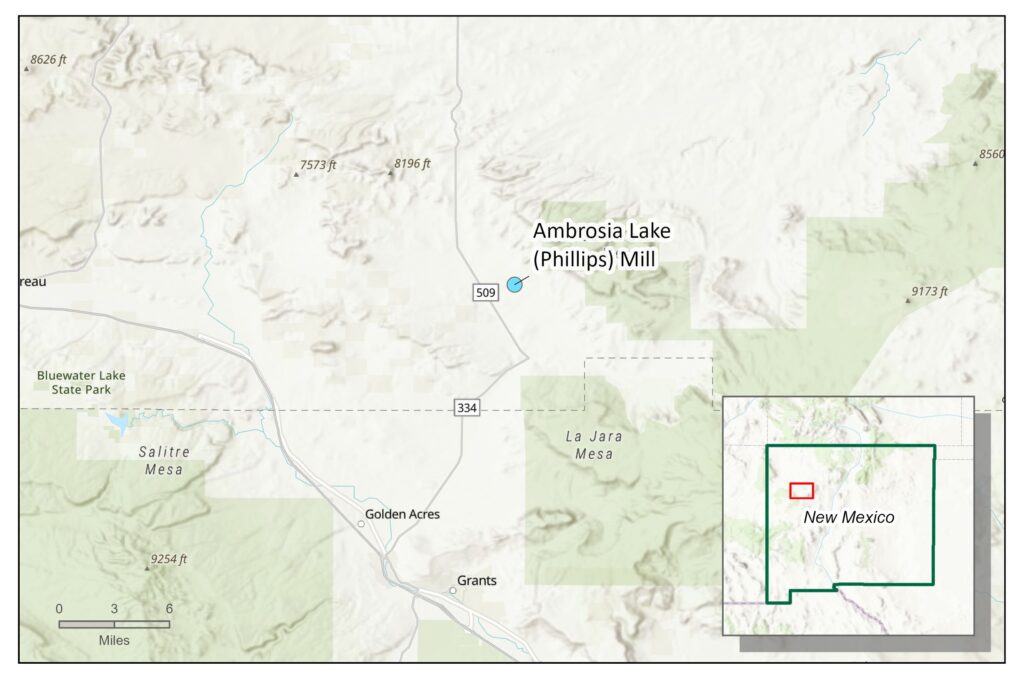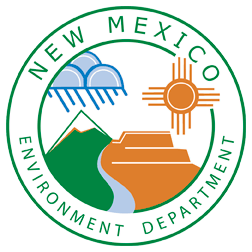Location
The Ambrosia Lake Disposal site is located in McKinley County, approximately 25 miles north of Grants, New Mexico. The site is within the Ambrosia Lake Mining District, near the Grants Mineral Belt.

Ownership and History
The Ambrosia Lake Disposal site is a former uranium processing mill originally built by Phillips Petroleum Company in 1957 to process uranium from nearby mines. The United Nuclear Corporation purchased the mill in 1963 and ceased milling operations but retained ownership. From the 1970s to early 1980s, United Nuclear Corporation operated an ion exchange system at the site, extracting uranium from mine water. Mill operations ceased in 1982 and left behind contaminated materials (primarily radioactive mill tailings) on 111 acres. Erosion via wind and water spread the tailings across 230 acres of the site. The U.S. Department of Energy Office of Legacy Management (DOE-LM) manages the site according to a site-specific Long-Term Surveillance Plan (LTSP). The site is included under a U.S. Nuclear Regulatory Commission (NRC) general license for Uranium Mill Tailings Radiation Control Act of 1987 (UMTRCA) Title I sites. UMTRCA Title I—regulated under Title 10 Code of Federal Regulations (CFR) Part 40.27—authorized the remediating uranium mill tailings inactive prior to the law’s enactment in 1978. Remediation activities took place under the Uranium Mill Tailings Remedial Action Project in accordance with standards set by the U.S. Environmental Protection Agency (EPA) in Title 40 CFR (Health and Environmental Standards for Uranium and Thorium Mill Tailings) Part 192.
Reclamation and Regulatory Jurisdiction
DOE conducted surface remediation at the site and in contaminated areas around the site between 1987 and 1995. Remediation activities included decommissioning the mill facilities as well as consolidating and encapsulating all contaminated materials on site in the disposal cell. The disposal cell, which covers 91 acres and holds 6.9 million dry tons of contaminated material, closed in 1995.
As mentioned above, DOE remediated 22 inactive uranium ore processing sites under the Uranium Mill Tailings Remedial Action Project in accordance with standards in Title 40 CFR Part 192, which establishes standards for protecting public health, safety, and the environment from radiological or non-radiological hazards associated with uranium and thorium ore processes, as well as their associated wastes. Subpart B of 40 CFR Part 192 regulates cleaning up contaminated groundwater at the mill sites. Radioactive tailings were encapsulated at the site in NRC-approved disposal cells.
Supplemental standards apply at UMTRCA sites where groundwater in the uppermost aquifer is classified as limited-use by meeting any of several criteria. According to NRC regulation, groundwater at the Ambrosia Lake site meets the criterion of low yield, meaning the quantity of water reasonably available for sustained continuous use is less than 150 gallons a day (40 CFR Part 192.11[e]). Groundwater is not a potential resource here and, therefore, no groundwater monitoring is required at the site according to DOE-LM. However, DOE-LM samples groundwater from three monitoring wells every three years to monitor disposal cell performance in accordance with a request from the New Mexico Environment Department and within the LTSP.
Timeline for Completion of Cleanup Activities
The DOE-LM remediated the site and the surrounding contaminated areas between 1987 and 1995. Surface remediation consisted of consolidating and encapsulating all contaminated material on site in the existing tailings disposal cell. Reclamation (excluding groundwater cleanup) is considered complete at this site. However, the DOE-LM manages the site according to a site-specific LTSP to ensure the disposal cell systems continue to prevent the release of contaminated materials. As part of the LTSP, DOE-LM conducts annual inspections of the site, performs maintenance as necessary, and samples three monitoring wells every three years. In accordance with 40 CFR Part 192.02(a), the disposal cell is designed to be effective for 1,000 years, to the extent reasonably achievable, and for at least 200 years in any case. The NRC general license for UMTRCA Title I sites has no expiration date and DOE-LM’s responsibility for the site will last indefinitely.
Coordination Between State and Federal Agencies
The DOE-LM is the primary regulator and manager of the site and monitors disposal cell performance in accordance with a request from NMED, and under the NRC general license provisions discussed above.
Anticipated Funding Requirements
DOE is the responsible party for the site and is therefore responsible for funding any remediation, clean up, or monitoring activities at the site.
Disclaimer
Site reviews in this report provide the reader with a general history and status of permitted mines and mills. For brevity, they may not provide all relevant details or agency actions related to each site.

